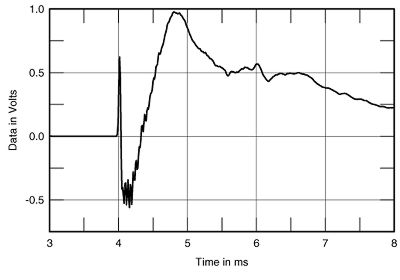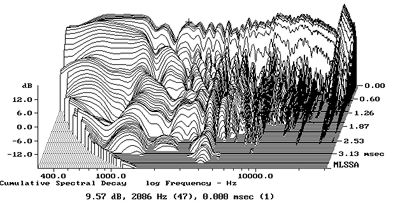| Columns Retired Columns & Blogs |
Acarian Systems Alón Circe loudspeaker Measurements part 3
But the speaker's perceived in-room balance will also be influenced by the way it behaves off-axis. Fig.9 shows the Circe's response plotted from 90 degrees on one side of the tweeter axis to 90 degrees on the other. This graph is hard to interpret, so I have also shown these same curves with the on-axis response subtracted from each (fig.10). Between 300Hz and 1kHz, the speaker's dipole nature can be clearly seen, but from 1kHz to 6kHz the Circe has wide, even dispersion. In effect, the lack of upper-midrange energy seen on-axis fills in to quite an extent to the speaker's sides. The larger the room and the farther away the listener sits, the better balanced the Alón's midrange and treble will sound. Conversely, the closer the listener sits and the drier the room acoustic, the more bothersome the discontinuity in the on-axis response will become.

Fig.9 Alón Circe, lateral response family at 50", from back to front: responses 90 degrees-5 degrees off-axis, response on tweeter axis, responses 5 degrees-90 degrees off-axis.

Fig.10 Alón Circe, lateral response family at 50", normalized to response on tweeter axis, from back to front: differences in response 90 degrees-5 degrees off-axis, reference response, differences in response 5 degrees-90 degrees off-axis.
Wes did comment on some changes in the Circes' soundstaging as he changed his listening height. In the vertical plane (fig.11), big suckouts appear in the speaker's upper crossover region for extreme off-axis angles. But smaller changes in listening height affect the integration between the midrange unit and tweeter. In fact, I got the flattest on-axis response just below the tweeter, around 40" from the floor.

Fig.11 Alón Circe, vertical response family at 50", from back to front: responses 10 degrees-5 degrees above HF axis, reference response, responses 5 degrees-15 degrees below HF axis.
In the time domain, the Circe's impulse response (fig.12) is dominated by the tweeter's ultrasonic ringing. However, some reasonably strong reflections can be seen in this graph at between 1.5ms and 2.5ms after the initial impulse. These can be more clearly seen in the speaker's step response (fig.13); as I said above, I suspect these are due to the midrange unit's sound bouncing back from the top plate and the top panel of the bass enclosure. The step response also shows that the Circe is not a time-coherent design, despite its gently sloped-back baffle and its use of what appear to be first-order crossover filters. While the tweeter and woofer are connected with positive acoustic polarity, the midrange is wired out of phase to give the best amplitude-response integration between it and the other two units.

Fig.12 Alón Circe, impulse response on tweeter axis at 50" (5ms time window, 30kHz bandwidth).

Fig.13 Alón Circe, step response on tweeter axis at 50" (5ms time window, 30kHz bandwidth).
As a result of the strong early reflections, the Circe's waterfall plot (fig.14) looks hashy. But this should not be misinterpreted as indicating the presence of resonances. Only the ridge of energy associated with the tweeter's ultrasonic peak is a true resonance.

Fig.14 Alón Circe, cumulative spectral-decay plot at 50" (0.15ms risetime).
These enigmatic measurements lead me to suspect that the Circe is very fussy when it comes to optimizing setup and room placement. However, as Wes found, with enough care taken, the result can be very musically satisfying.—John Atkinson
- Log in or register to post comments




































